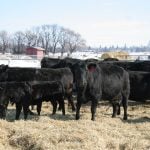RED DEER, Alta. – Understanding sheep behavior can create a productive flock that is fertile and mothers its lambs well.
Tips were offered by animal behaviorist Joe Stookey from the Western College of Veterinary Medicine during the recent Alberta Sheep Symposium.
The first thing to remember is that sheep are social animals that become distressed if separated from their flocks.
Isolation at birth is often necessary to help lambs bond with their mothers although Stookey said only half of all ewes deliver away from their flock.
Read Also

Lending policy still focused on primary producers: Farm Credit Canada
Farm Credit Canada said it has not changed its business practices and remains committed to supporting all producers, after a report from an Ottawa-based media outlet claimed otherwise.
To get a good start, a newborn lamb must immediately have the strength to get up and suckle in order to receive a healthy dose of colostrum.
“Bonding is extremely important for a lamb’s survival,” said Stookey.
Ewes have a specific behavior pattern which aids bonding and recognition of their own lambs. After delivery, she stands up, approaches her lamb, sniffs it, licks the birth fluids, navel and head. If she is #interrupted in this behavior or has a difficult birth, she may reject her lamb.
Studies show ewes recognize their own lambs’ faces and odor and will push away strangers trying to suckle. This makes fostering difficult when there are orphans or one ewe has borne more lambs than she can nurse.
When rejection occurs, Stookey said it helps to rub birth fluids across the muzzle and tongue of the dam after delivery.
“This technique seems to jumpstart the maternal response in females that become traumatized from the difficult delivery and the presence of people,” he said.
If they have birthed twins, it’s easier for one to get separated and follow another ewe. The lamb may be rejected and could die if it doesn’t find some milk.
To keep the family units together, Stookey recommended setting up lambing cubicles for expectant ewes. The pen is small at about 1.8 x 1.8 metres with a 60 centimetre high threshold for her to cross over. This same threshold blocks newborns from wandering away. About one cubicle for every 10 lambs is sufficient.
Tricks of the trade
Stookey suggested a number of techniques for cross-fostering lambs. He added that some ewes will easily adopt a lamb without any tricks.
- The first technique is to place the ewe in an adoption crate where she is physically restrained. She is prevented from interacting with any lambs. She is able to stand up and lie and is fed and watered. Normally she will accept the lambs placed in the pen with her in three to five days.
- Skinning a dead lamb and placing the hide over an orphan is an old and effective trick. If possible, however, Stookey recommends not allowing a ewe to bond with a stillborn lamb because there are other fostering techniques that are easier.
- Using strong odors to bond ewes and lambs can be successful. One of the most successful odors is neatsfoot oil. The oil is applied to the ewe’s own lamb so she associates this smell with her own offspring. The following day the orphan is added. Her own lamb and the orphan receive a rubdown of the oil and she assumes they are both hers.
- Odor transfer can be done in another way. Lambing jackets are used to transfer the odor of the ewe’s lamb onto a foster lamb. Single lambs wear a special jacket for 24 hours or more. The ewe associates this jacket with her offspring. The jacket is then transferred to the foster lamb. This technique works even better if her own lamb is taken away temporarily. After she has allowed the orphan to suckle, her own lamb is returned.
- Smearing a lamb with birth fluid attracts ewes. The fluid can be frozen on rags or towels and rubbed onto a foster lamb when required. Ewes which delivered singles will often adopt a second one if it is soaked with birth fluid.















